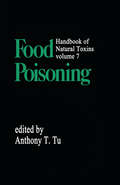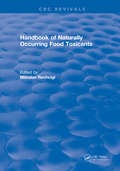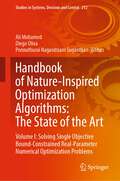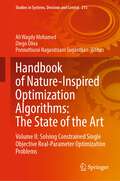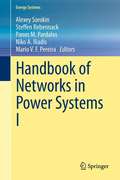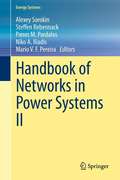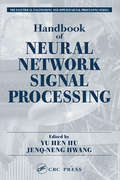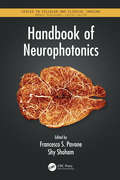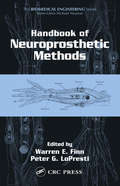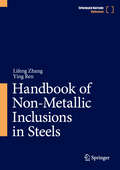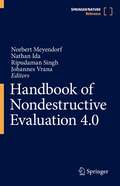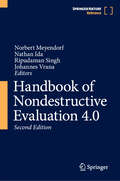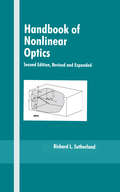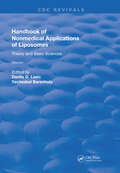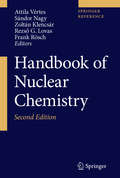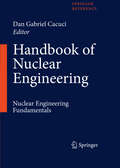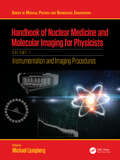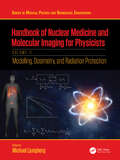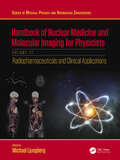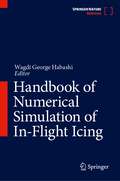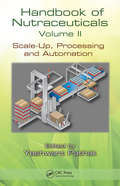- Table View
- List View
Handbook of Natural Toxins: Food Poisoning
by Anthony T. TuThis resource discusses all aspects of food poisoning and its sources such as bacteria, plant, and fungus - presenting the pathogens and food toxins in detail. Featuring contributions from over 30 leading authorities in the field, Food Poisoning ...: describes bacterial food contaminants including staphylococcal, salmonellae, E. coli, Clostridium perfringens, Bacillus cereus, cholera, and botulism; covers the prevention and treatment of mushroom and other poisonings from grains and plant-type foods; explains how to aid allergic reactions resulting from eating certain foods; identifies which kinds of seafood may cause severe poisoning; explores teratogenic aspects of food poisoning, outlining which foods pregnant women should avoid; and shows how those sensitive to nitrosamines can avoid such food poisoning.;Extensively referenced with more than 2200 literature citations, Volume 7: Food Poisoning serves as essential reading for toxicologists, microbiologists, dietitians and nutritionists, public health officials, food scientists and technologists, agricultural chemists and biochemists, bacteriologists, and graduate-level students in food science and toxicology.
Handbook of Naturally Occurring Food Toxicants (Crc Series In Nutrition And Food)
by Miloslav RechciglIn the last decade an increased concern has been voiced against various environmental hazards, particularly chemicals that may cause harm to humans or animals. Numerous studies which have dealt with this subject invariably have focused on chemical contaminants of some component of a food chain. In contrast, much less attention has been paid to the potentially harmful substances that may occur in foodstuffs naturally. The purpose of this Handbook is to sensitize the reader to this problem and to provide a systematic overview of the most important naturally occurring food toxicants. The Handbook should be of interest to anybody who is concerned with nutritive and health aspects of food. Inasmuch as many of the discussed toxicants can be removed or destroyed by a suitable method of food rpocessing it should be of special value to food technologists.
Handbook of Naturally Occurring Insecticidal Toxins, The
by Opender KoulNaturally occurring toxins are among the most complicated and lethal in existence. Plant species, microorganisms and marine flora and fauna produce hundreds of toxic compounds for defence and to promote their chances of survival, and these can be isolated and appropriated for our own use. Many of these toxins have yet to be thoroughly described, despite being studied for years. Focusing on the natural toxins that are purely toxic to insects, this book contains over 500 chemical structures. It discusses the concepts and mechanisms involved in toxicity, bioassay procedures for evaluation, structure-activity relationships, and the potential for future commercialization of these compounds. A comprehensive review of the subject, this book forms an important source of information for researchers and students of crop protection, pest control, phytochemistry and those dealing in insect-plant interactions.
Handbook of Nature-Inspired Optimization Algorithms: Volume I: Solving Single Objective Bound-Constrained Real-Parameter Numerical Optimization Problems (Studies in Systems, Decision and Control #212)
by Ponnuthurai Nagaratnam Suganthan Diego Oliva Ali MohamedThe introduction of nature-inspired optimization algorithms (NIOAs), over the past three decades, helped solve nonlinear, high-dimensional, and complex computational optimization problems. NIOAs have been originally developed to overcome the challenges of global optimization problems such as nonlinearity, non-convexity, non-continuity, non-differentiability, and/or multimodality which traditional numerical optimization techniques had difficulties solving. The main objective for this book is to make available a self-contained collection of modern research addressing the general bound-constrained optimization problems in many real-world applications using nature-inspired optimization algorithms. This book is suitable for a graduate class on optimization, but will also be useful for interested senior students working on their research projects.
Handbook of Nature-Inspired Optimization Algorithms: Volume II: Solving Constrained Single Objective Real-Parameter Optimization Problems (Studies in Systems, Decision and Control #213)
by Ponnuthurai Nagaratnam Suganthan Diego Oliva Ali Wagdy MohamedThis book presents recent contributions and significant development, advanced issues, and challenges. In real-world problems and applications, most of the optimization problems involve different types of constraints. These problems are called constrained optimization problems (COPs). The optimization of the constrained optimization problems is considered a challenging task since the optimum solution(s) must be feasible. In their original design, evolutionary algorithms (EAs) are able to solve unconstrained optimization problems effectively. As a result, in the past decade, many researchers have developed a variety of constraint handling techniques, incorporated into (EAs) designs, to counter this deficiency.The main objective for this book is to make available a self-contained collection of modern research addressing the general constrained optimization problems in many real-world applications using nature-inspired optimization algorithms. This book is suitable for a graduate class on optimization, but will also be useful for interested senior students working on their research projects.
Handbook of Networks in Power Systems I (Energy Systems)
by Panos M. Pardalos Alexey Sorokin Niko A. Iliadis Steffen Rebennack Mario V. F. PereiraEnergy has been an inevitable component of human lives for decades. Recent rapid developments in the area require analyzing energy systems not as independent components but rather as connected interdependent networks. The Handbook of Networks in Power Systems includes the state-of-the-art developments that occurred in the power systems networks, in particular gas, electricity, liquid fuels, freight networks, as well as their interactions. The book is separated into two volumes with three sections, where one scientific paper or more are included to cover most important areas of networks in power systems. The first volume covers topics arising in electricity network, in particular electricity markets, smart grid, network expansion, as well as risk management. The second volume presents problems arising in gas networks; such as scheduling and planning of natural gas systems, pricing, as well as optimal location of gas supply units. In addition, the second volume covers the topics of interactions between energy networks. Each subject is identified following the activity on the domain and the recognition of each subject as an area of research. The scientific papers are authored by world specialists on the domain and present either state-of-the-arts reviews or scientific developments.
Handbook of Networks in Power Systems II
by Panos M. Pardalos Alexey Sorokin Niko A. Iliadis Mario V. Pereira Steffen RebennackEnergy has been an inevitable component of human lives for decades. Recent rapid developments in the area require analyzing energy systems not as independent components but rather as connected interdependent networks. The Handbook of Networks in Power Systems includes the state-of-the-art developments that occurred in the power systems networks, in particular gas, electricity, liquid fuels, freight networks, as well as their interactions. The book is separated into two volumes with three sections, where one scientific paper or more are included to cover most important areas of networks in power systems. The first volume covers topics arising in electricity network, in particular electricity markets, smart grid, network expansion, as well as risk management. The second volume presents problems arising in gas networks; such as scheduling and planning of natural gas systems, pricing, as well as optimal location of gas supply units. In addition, the second volume covers the topics of interactions between energy networks. Each subject is identified following the activity on the domain and the recognition of each subject as an area of research. The scientific papers are authored by world specialists on the domain and present either state-of-the-arts reviews or scientific developments.
Handbook of Networks in Power Systems II (Energy Systems)
by Panos M. Pardalos Alexey Sorokin Niko A. Iliadis Steffen Rebennack Mario V. F. PereiraEnergy has been an inevitable component of human lives for decades. Recent rapid developments in the area require analyzing energy systems not as independent components but rather as connected interdependent networks. The Handbook of Networks in Power Systems includes the state-of-the-art developments that occurred in the power systems networks, in particular gas, electricity, liquid fuels, freight networks, as well as their interactions. The book is separated into two volumes with three sections, where one scientific paper or more are included to cover most important areas of networks in power systems. The first volume covers topics arising in electricity network, in particular electricity markets, smart grid, network expansion, as well as risk management. The second volume presents problems arising in gas networks; such as scheduling and planning of natural gas systems, pricing, as well as optimal location of gas supply units. In addition, the second volume covers the topics of interactions between energy networks. Each subject is identified following the activity on the domain and the recognition of each subject as an area of research. The scientific papers are authored by world specialists on the domain and present either state-of-the-arts reviews or scientific developments.
Handbook of Neural Network Signal Processing (Electrical Engineering & Applied Signal Processing Series)
by YU HEN HU AND JENQ-NENG HWANGThe use of neural networks is permeating every area of signal processing. They can provide powerful means for solving many problems, especially in nonlinear, real-time, adaptive, and blind signal processing. The Handbook of Neural Network Signal Processing brings together applications that were previously scattered among various publications to provide an up-to-date, detailed treatment of the subject from an engineering point of view.The authors cover basic principles, modeling, algorithms, architectures, implementation procedures, and well-designed simulation examples of audio, video, speech, communication, geophysical, sonar, radar, medical, and many other signals. The subject of neural networks and their application to signal processing is constantly improving. You need a handy reference that will inform you of current applications in this new area. The Handbook of Neural Network Signal Processing provides this much needed service for all engineers and scientists in the field.
Handbook of Neurophotonics (Series in Cellular and Clinical Imaging)
by Francesco S. Pavone Shy ShohamThe Handbook of Neurophotonics provides a dedicated overview of neurophotonics, covering the use of advanced optical technologies to record, stimulate, and control the activity of the brain, yielding new insight and advantages over conventional tools due to the adaptability and non-invasive nature of light. Including 32 colour figures, this book addresses functional studies of neurovascular signaling, metabolism, electrical excitation, and hemodynamics, as well as clinical applications for imaging and manipulating brain structure and function. The unifying theme throughout is not only to highlight the technology, but to show how these novel methods are becoming critical to breakthroughs that will lead to advances in our ability to manage and treat human diseases of the brain. Key Features: Provides the first dedicated book on state-of-the-art optical techniques for sensing and imaging across at the cellular, molecular, network, and whole brain levels. Highlights how the methods are used for measurement, control, and tracking of molecular events in live neuronal cells, both in basic research and clinical practice. Covers the entire spectrum of approaches, from optogenetics to functional methods, photostimulation, optical dissection, multiscale imaging, microscopy, and structural imaging. Includes chapters that show use of voltage-sensitive dye imaging, hemodynamic imaging, multiphoton imaging, temporal multiplexing, multiplane microscopy, optoacoustic imaging, near-infrared spectroscopy, and miniature neuroimaging devices to track cortical brain activity.
Handbook of Neuroprosthetic Methods
by Warren E. Finn Peter G. LoPrestiWork in the field of neuroprosthetics requires multidisciplinary teams, but these collaborators must meet on common ground to develop an understanding of the capabilities and limitations of each part of a bioengineering project. The Handbook of Neuroprosthetic Methods provides a comprehensive resource for the techniques, methodologies, and options
Handbook of New Technologies for Genetic Improvement of Legumes
by P. B. KirtiA comprehensive and groundbreaking collection of ideas for plant improvement Most of the world's supply of legumes is cultivated under adverse conditions that make this commercially important crop susceptible to the vagaries of nature and damaging stresses. Genetic manipulation has become a proven way for cultivators to battle these pro
Handbook of Non-Metallic Inclusions in Steels
by Lifeng Zhang Ying RenThis handbook reports fundamentals, industrial practices and new aspects for the formation and control solution of non-metallic inclusions in different grades of steels. It summarizes the latest research achievements of thermodynamics and kinetics, such as deoxidation of real steels rather than pure iron, precise calcium treatment, prediction of the amount, size, composition and spatial distribution of inclusions in steel continuous casting semis which were rarely reported in other books in this field. It is a useful reference for researchers in steel industries for the control of non-metallic inclusions in steel, and the production of high-quality steels in industries such as automobiles, household electric appliances, bearings, electric transformers, high-speed trains, oil pipes and cutting wires.
Handbook of Nondestructive Evaluation 4.0
by Nathan Ida Ripudaman Singh Norbert Meyendorf Johannes VranaThis handbook comprehensively covers the cutting-edge trends and techniques essential for the integration of nondestructive evaluation (NDE) into the changing face of the modern industrial landscape. In particular, it delves into the marriage of NDE with new techniques in e.g. data mining, cloud computing and autonomous operation, highlighting the potential for cyber-physical controlled production and discussing the myriad possible applications across many different industries.The Handbook of NDE 4.0 centers around the Internet of Things and Industry 4.0 – the next generation of industrial production encompassing all aspects of networking across all industrial areas. It discusses the adaptation of existing NDE techniques to emerging new technological areas, such as 3D printing, via the introduction of cyber systems into the inspection and maintenance processes. In addition, the handbook covers topics such as the management and processing of big data with respect to real-time monitoring of structural integrity and reliable inspection of individual components. Remote NDE to include competence not available on-site will be a potential technique to increase reliability of NDE inspections by integrating additional specialist inputs into the decision process by methods such as telepresence, thereby better leveraging the scarce resources of senior inspectors into industrial inspections at multiple sites.The handbook houses a wealth of essential information to help academics, industry professionals and entrepreneurs navigate through this burgeoning new field. The material in this handbook is presented with the intention of ultimately improving human safety through reliable inspections and dependable maintenance of critical infrastructure, while also enhancing business value through reduced downtime, affordable maintenance, and talent optimization.
Handbook of Nondestructive Evaluation 4.0
by Nathan Ida Norbert Meyendorf Johannes Vrana Ripudaman Ripi SinghThis handbook, now as second edition, continues to comprehensively cover the cutting-edge trends and techniques essential for the integration of nondestructive evaluation (NDE) into the changing face of the modern industrial landscape. In particular, it delves into the marriage of NDE with new techniques in e.g. data mining and management, cloud computing, autonomous operation, AI for data analysis and decision making, as well as cyber security, highlighting the potential for cyber-physical controlled production and discussing the myriad possible applications across many different industries. The Handbook of NDE 4.0 centers around the Industry 4.0 philosophy – the next generation of industrial production encompassing all aspects of networking across all industrial areas. It discusses the adaptation of existing NDE techniques to emerging new technological areas, such as 3D printing, via the introduction of cyber systems into the inspection and maintenance processes. In addition, the handbook covers topics such as the management and processing of big data with respect to real-time monitoring of structural integrity and reliable inspection of individual components. Remote NDE to include competence not available on-site will be a potential technique to increase reliability of NDE inspections by integrating additional specialist inputs into the decision process by methods such as telepresence, thereby better leveraging the scarce resources of senior inspectors into industrial inspections at multiple sites. The handbook also includes non-technical topics of direct relevance to leadership, management, and adoption of this new philosophy. The handbook houses a wealth of essential information to help academics, industry professionals, regulatory bodies, and entrepreneurs navigate through this burgeoning new field. The material in this handbook is presented with the intention of ultimately improving human safety through reliable inspections and dependable maintenance of critical infrastructure, while also enhancing business value through reduced downtime, affordable maintenance, and talent optimization. The content is positioned to inspire NDE professionals to think broadly in terms of their role as continuous value add rather than discrete decision support. This second edition contains many new chapters, and half of all chapters were revised from the 1st edition, based on the engagement of authors through global platforms such as the ICDNT Specialist International Group on NDE 4.0 and the International conference series on NDE 4.0.
Handbook of Nonlinear Optics
by Richard L. SutherlandExamining classic theories, experimental methods, and practical formulas for exploration of the core topics in nonlinear optics, the second edition of this acclaimed text was extensively revised to reflect recent advances in the analysis and modification of material properties for application in frequency conversion, optical switching and limiting,
Handbook of Nonmedical Applications of Liposomes: Theory and Basic Sciences (Routledge Revivals #1)
by Danilo D. Lasic Yechezkel BarenholzFirst published in 1996, liposomes have become an important model in fundamental biomembrane research, including biophysical, biochemical, and cell biological studies of membranes and cell function. They are thoroughly studied in several applications, such as drug delivery systems in medical applications and as controlled release systems, microencapsulating media, signal carriers, support matrices, and solubilizers in other applications. While medical applications have been extensively reviewed in recent literature, there is a need for easily accessible information on applications for liposomes beyond pharmacology and medicine. The Handbook of Nonmedical Applications of Liposomes fills this void.This unique new handbook series presents recent developments in the use of liposomes in many scientific disciplines, from studies on the origin of life, protein function, and vesicle shapes, to applications in cosmetics, diagnostics, ecology, bioreclamation, and the food industry. In these volumes many of the top experts contribute extensive reviews of their work.
Handbook of Nuclear Chemistry
by Attila Vértes Frank Rösch Sándor Nagy Rezso György Lovas Zoltán KlencsárThis revised and extended 6 volume handbook set is the most comprehensive and voluminous reference work of its kind in the field of nuclear chemistry. The Handbook set covers all of the chemical aspects of nuclear science starting from the physical basics and including such diverse areas as the chemistry of transactinides and exotic atoms as well as radioactive waste management and radiopharmaceutical chemistry relevant to nuclear medicine. The nuclear methods of the investigation of chemical structure also receive ample space and attention. The international team of authors consists of scores of world-renowned experts - nuclear chemists, radiopharmaceutical chemists and physicists - from Europe, USA, and Asia. The Handbook set is an invaluable reference for nuclear scientists, biologists, chemists, physicists, physicians practicing nuclear medicine, graduate students and teachers - virtually all who are involved in the chemical and radiopharmaceutical aspects of nuclear science. The Handbook set also provides further reading via the rich selection of references.
Handbook of Nuclear Engineering
by Dan Gabriel CacuciThe Handbook of Nuclear Engineering is an authoritative compilation of information regarding methods and data used in all phases of nuclear engineering. Addressing nuclear engineers and scientists at all academic levels, this five volume set provides the latest findings in nuclear data and experimental techniques, reactor physics, kinetics, dynamics and control. Readers will also find a detailed description of data assimilation, model validation and calibration, sensitivity and uncertainty analysis, fuel management and cycles, nuclear reactor types and radiation shielding. A discussion of radioactive waste disposal, safeguards and non-proliferation, and fuel processing with partitioning and transmutation is also included. As nuclear technology becomes an important resource of non-polluting sustainable energy in the future, The Handbook of Nuclear Engineering is an excellent reference for practicing engineers, researchers and professionals.
Handbook of Nuclear Medicine and Molecular Imaging for Physicists: Instrumentation and Imaging Procedures, Volume I (Series in Medical Physics and Biomedical Engineering)
by Michael LjungbergThis state-of-the-art handbook, the first in a series that provides medical physicists with a comprehensive overview into the field of nuclear medicine, is dedicated to instrumentation and imaging procedures in nuclear medicine. It provides a thorough treatment on the cutting-edge technologies being used within the field, in addition to touching upon the history of their use, their development, and looking ahead to future prospects. This text will be an invaluable resource for libraries, institutions, and clinical and academic medical physicists searching for a complete account of what defines nuclear medicine. The most comprehensive reference available providing a state-of-the-art overview of the field of nuclear medicine Edited by a leader in the field, with contributions from a team of experienced medical physicists Includes the latest practical research in the field, in addition to explaining fundamental theory and the field's history
Handbook of Nuclear Medicine and Molecular Imaging for Physicists: Modelling, Dosimetry and Radiation Protection, Volume II (ISSN)
by Michael LjungbergMathematical modelling is an important part of nuclear medicine. Therefore, several chapters of this book have been dedicated towards describing this topic. In these chapters, an emphasis has been put on describing the mathematical modelling of the radiation transport of photons and electrons, as well as on the transportation of radiopharmaceuticals between different organs and compartments. It also includes computer models of patient dosimetry. Two chapters of this book are devoted towards introducing the concept of biostatistics and radiobiology. These chapters are followed by chapters detailing dosimetry procedures commonly used in the context of diagnostic imaging, as well as patient-specific dosimetry for radiotherapy treatments. For safety reasons, many of the methods used in nuclear medicine and molecular imaging are tightly regulated. Therefore, this volume also highlights the basic principles for radiation protection. It discusses the process of how guidelines and regulations aimed at minimizing radiation exposure are determined and implemented by international organisations. Finally, this book describes how different dosimetry methods may be utilized depending on the intended target, including whole-body or organ-specific imaging, as well as small-scale to cellular dosimetry.This text will be an invaluable resource for libraries, institutions, and clinical and academic medical physicists searching for a complete account of what defines nuclear medicine. The most comprehensive reference available providing a state-of-the-art overview of the field of nuclear medicine Edited by a leader in the field, with contributions from a team of experienced medical physicists, chemists, engineers, scientists, and clinical medical personnel Includes the latest practical research in the field, in addition to explaining fundamental theory and the field's history
Handbook of Nuclear Medicine and Molecular Imaging for Physicists: Radiopharmaceuticals and Clinical Applications, Volume III (Series in Medical Physics and Biomedical Engineering)
by Michael LjungbergThis state-of-the-art handbook, the third and final in a series that provides medical physicists with a comprehensive overview into the field of nuclear medicine, focuses on highlighting the production and application of radiopharmaceuticals. With this, the book also describes the chemical composition of these compounds, as well as some of the main clinical applications where radiopharmaceuticals may be used. Following an introduction to the field of radiopharmacy, three chapters in this book are dedicated towards in-depth descriptions of common radionuclides and radiopharmaceuticals used during diagnostic studies utilizing planar/Single Photon Emission Computed Tomography (SPECT) imaging, in addition to during Positron Emission Tomography (PET) imaging, and, finally, radiotherapy. These chapters are followed by those describing procedures relating to quality control and manufacturing (good manufacturing practices) also encompassing aspects such as environmental compliance. Furthermore, this volume illustrates how facilities handling these chemicals should be designed to comply with set regulations. Like many pharmaceuticals, the development of radiopharmaceuticals relies heavily on the use of mouse models. Thus, the translation of radiopharmaceuticals (i.e., the process undertaken to assure that the functionality and safety of a newly developed drug is maintained also in a human context), is covered in a later chapter. This is followed by a chapter emphasising the importance of safe waste disposal and how to assure that these procedures meet the requirements set for the disposal of hazardous waste. Several chapters have also been dedicated towards describing various medical procedures utilizing clinical nuclear medicine as a tool for diagnostics and therapeutics. As physicists may be involved in clinical trials, a chapter describing the procedures and regulations associated with these types of studies is included. This is followed by a chapter focusing on patient safety and another on an imaging modality not based on ionizing radiation – ultrasound. Finally, the last chapter of this book discusses future perspectives of the field of nuclear medicine. This text will be an invaluable resource for libraries, institutions, and clinical and academic medical physicists searching for a complete account of what defines nuclear medicine. The most comprehensive reference available providing a state-of-the-art overview of the field of nuclear medicine Edited by a leader in the field, with contributions from a team of experienced medical physicists, chemists, engineers, scientists, and clinical medical personnel Includes the latest practical research in the field, in addition to explaining fundamental theory and the field's history
Handbook of Numerical Simulation of In-Flight Icing
by Wagdi George HabashiThis Handbook of Numerical Simulation of In-Flight Icing covers an array of methodologies and technologies on numerical simulation of in-flight icing and its applications. Comprised of contributions from internationally recognized experts from the Americas, Asia, and the EU, this authoritative, self-contained reference includes best practices and specification data spanning the gamut of simulation tools available internationally that can be used to speed up the certification of aircraft and make them safer to fly into known icing. The collection features nine sections concentrating on aircraft, rotorcraft, jet engines, UAVs; ice protection systems, including hot-air, electrothermal, and others; sensors and probes, CFD in the aid of testing, flight simulators, and certification process acceleration methods. Incorporating perspectives from academia, commercial, government R&D, the book is ideal for a range of engineers and scientists concerned with in-flight icing applications.
Handbook of Nutraceuticals Volume I: Ingredients, Formulations, and Applications
by Yashwant PathakThe first reference of its kind, this volume analyzes nutraceutical extracts and formulations in a pharmacopoeia-like manner. Introductory chapters provide detailed scientific information on characterization and methods for developing reproducible products, including Good Manufacturing Procedure (cGMP) requirements. All of the individual monographs on more than 175 nutraceuticals follow a unified format. Each is characterized by origin and as many as 17 properties, including non-proprietary names, chemical name, CAS no., and applications. A second section focuses on formulations aimed at specific diseases or disorders. The text also includes chapters on safety and toxicity of nutraceuticals.
Handbook of Nutraceuticals Volume II: Scale-Up, Processing and Automation
by Yashwant Vishnupant PathakDue in part to an absence of universally accepted standardization methods, nutraceuticals and functional foods face regulatory ignorance, marketing incompetence and ethical impunity. Even though many researchers believe that there is a connection between nutraceuticals and functional foods and reduced health care expenses as well as disease prevent
